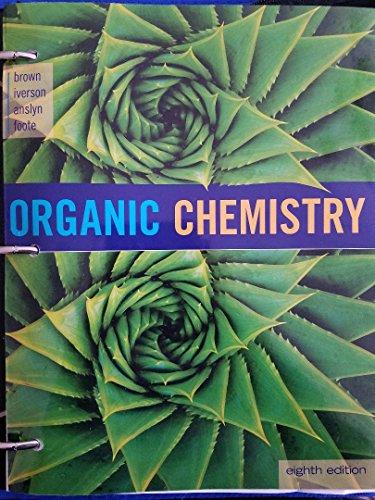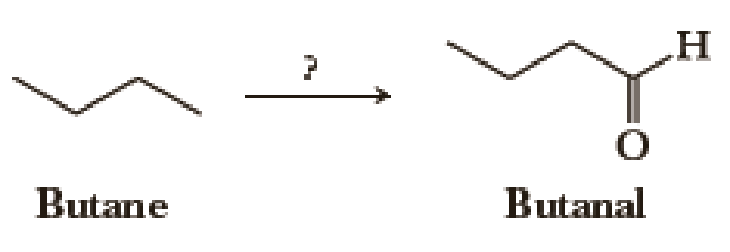
Organic Chemistry, Loose-leaf Version
8th Edition
ISBN: 9781305865549
Author: William H. Brown, Brent L. Iverson, Eric Anslyn, Christopher S. Foote
Publisher: Cengage Learning
expand_more
expand_more
format_list_bulleted
Concept explainers
Textbook Question
Chapter 10, Problem 10.54P
Using your reaction roadmap as a guide, show how to convert butane into butanal. Show all reagents needed and all molecules synthesized along the way.

Expert Solution & Answer
Trending nowThis is a popular solution!

Students have asked these similar questions
Thermodynamic analysis of electrified interfaces.
Conduct a brief thermodynamic analysis of electrified interfaces. Gibbs model.
ELECTROCAPILAR EQUATION FOR IDEALLY POLARIZED ELECTRODES.
Chapter 10 Solutions
Organic Chemistry, Loose-leaf Version
Ch. 10.1 - Write IUPAC names for these alcohols and include...Ch. 10.1 - Classify each alcohol as primary, secondary, or...Ch. 10.1 - Write IUPAC names for these unsaturated alcohols.Ch. 10.2 - Arrange these compounds in order of increasing...Ch. 10.2 - Prob. 10.5PCh. 10.4 - Predict the position of equilibrium for this...Ch. 10.5 - Show how to convert (R)-2-pentanol to...Ch. 10.6 - Draw structural formulas for the alkenes formed by...Ch. 10.6 - Propose a mechanism to account for this...Ch. 10.7 - Propose a mechanism to account for the following...
Ch. 10.7 - Prob. AQCh. 10.7 - Prob. BQCh. 10.7 - Prob. CQCh. 10.7 - Prob. DQCh. 10.7 - Which step in the reaction would you expect to be...Ch. 10.7 - Prob. FQCh. 10.7 - Prob. GQCh. 10.8 - Prob. 10.11PCh. 10.8 - Prob. AQCh. 10.8 - Prob. BQCh. 10.8 - Prob. CQCh. 10.8 - Why does nature use a reagent as complex as NAD+...Ch. 10.8 - -Hydroxyketones and -hydroxyaldehydes are also...Ch. 10.9 - Write IUPAC names for these thiols.Ch. 10 - Which are secondary alcohols?Ch. 10 - Name each compound.Ch. 10 - Prob. 10.16PCh. 10 - Name and draw structural formulas for the eight...Ch. 10 - Arrange these compounds in order of increasing...Ch. 10 - Arrange these compounds in order of increasing...Ch. 10 - Prob. 10.20PCh. 10 - Prob. 10.21PCh. 10 - Arrange the compounds in each set in order of...Ch. 10 - Prob. 10.23PCh. 10 - The decalinols A and B can be equilibrated using...Ch. 10 - Prob. 10.25PCh. 10 - Select the stronger acid from each pair and...Ch. 10 - Prob. 10.27PCh. 10 - In each equilibrium, label the stronger acid, the...Ch. 10 - Write equations for the reaction of 1-butanol with...Ch. 10 - Write equations for the reaction of 2-butanol with...Ch. 10 - Prob. 10.31PCh. 10 - When (R)-2-butanol is left standing in aqueous...Ch. 10 - Two diastereomeric sets of enantiomers, A/B and...Ch. 10 - Acid-catalyzed dehydration of 3-methyl-2-butanol...Ch. 10 - Show how you might bring about the following...Ch. 10 - Propose a mechanism for the following pinacol...Ch. 10 - Prob. 10.37PCh. 10 - Show how each alcohol or diol can be prepared from...Ch. 10 - Dihydropyran is synthesized by treating...Ch. 10 - Show how to convert propene to each of these...Ch. 10 - Prob. 10.41PCh. 10 - Prob. 10.42PCh. 10 - The tosylate of a primary alcohol normally...Ch. 10 - Prob. 10.44PCh. 10 - Show how to convert cyclohexene to each compound...Ch. 10 - Prob. 10.46PCh. 10 - Ethanol (CH3CH2OH) and dimethyl ether (CH3OCH3)...Ch. 10 - Prob. 10.48PCh. 10 - Prob. 10.49PCh. 10 - Prob. 10.50PCh. 10 - Write the products of the following sequences of...Ch. 10 - Alcohols are important for organic synthesis,...Ch. 10 - Using your reaction roadmap as a guide, show how...Ch. 10 - Using your reaction roadmap as a guide, show how...Ch. 10 - Using your reaction roadmap as a guide, show how...Ch. 10 - Using your reaction roadmap as a guide, show how...Ch. 10 - Prob. 10.57PCh. 10 - Prob. 10.58PCh. 10 - Prob. 10.59P
Additional Science Textbook Solutions
Find more solutions based on key concepts
An obese 55-year-old woman consults her physician about minor chest pains during exercise. Explain the physicia...
Biology: Life on Earth with Physiology (11th Edition)
2. Which of the following is the best example of the use of a referent? _
a. A red bicycle
b. Big as a dump tru...
Physical Science
45. Calculate the mass of nitrogen dissolved at room temperature in an 80.0-L home aquarium. Assume a total pre...
Chemistry: Structure and Properties (2nd Edition)
Gregor Mendel never saw a gene, yet he concluded that some inherited factors were responsible for the patterns ...
Campbell Essential Biology (7th Edition)
Knowledge Booster
Learn more about
Need a deep-dive on the concept behind this application? Look no further. Learn more about this topic, chemistry and related others by exploring similar questions and additional content below.Similar questions
- Briefly state the electrocapillary equation for ideally polarized electrodes.arrow_forwardWhat is surface excess according to the Gibbs model?arrow_forwardUsing Benzene as starting materid show how each of the Following molecules Contel Ve syntheswed CHI 9. b -50311 с CHY 503H Ночто d. อ •NOV e 11-0-650 NO2arrow_forward
- The molecule PYRIDINE, 6th electrons and is therefore aromatre and is Assigned the Following structure contering Since aromatk moleculoy undergo electrophilic anomatic substitution, Pyridine shodd undergo The Following reaction + HNO3 12504 a. write all of the possible Mononitration Products that could Result From this reaction 18. Bared upon the reaction mechanison determime which of these producty would be the major Product of the hegetionarrow_forwarda. Explain Why electron withdrawing groups tend to be meta-Directors. Your answer Should lyclude all apropriate. Resonance contributing Structures fo. Explain why -ll is an outho -tura drccton even though chlorine has a very High Electronegativityarrow_forward9. Write Me product as well as the reaction Mechanism For each of the Following Vanctions +H₂504 4.50+ T C. +212 Fellz 237 b. Praw the potential energy Diagrams For each OF Mese Rauctions and account For any differences that appear in the two potential Puergy Diagrams which of here two reactions 19 Found to be Reversable, Rationalice your answer based upon the venation mechanisms and the potential energy diagrams.arrow_forward
- 9. Write Me product as well as the reaction Mechanism For each of the Following Veritious +H2504 4.50+ + 1/₂ Felly ◎+ 7 b. Praw he potential energy Diagrams For each OF Mese Ronctions and account for any differences that appeak in the two potential Puergy Diagramsarrow_forwardDraw the major product of this reaction. Ignore inorganic byproducts. Incorrect, 3 attempts remaining 1. excess Br2, NaOH 2. neutralizing workup Qarrow_forwardGiven the electrode Pt | Ag | Ag+ (aq), describe it.arrow_forward
- At 25°C, the reaction Zn2+ + 2e ⇄ Zn has a normal equilibrium potential versus the saturated calomel electrode of -1.0048 V. Determine the normal equilibrium potential of Zn versus the hydrogen electrode.Data: The calomel electrode potential is E° = 0.2420 V versus the normal hydrogen electrode.arrow_forwardElectrochemistry. State the difference between E and E0.arrow_forwardIn an electrolytic cell, the positive pole is always assumed to be on the right side of the battery notation. Is that correct?arrow_forward
arrow_back_ios
SEE MORE QUESTIONS
arrow_forward_ios
Recommended textbooks for you
 Organic ChemistryChemistryISBN:9781305580350Author:William H. Brown, Brent L. Iverson, Eric Anslyn, Christopher S. FootePublisher:Cengage Learning
Organic ChemistryChemistryISBN:9781305580350Author:William H. Brown, Brent L. Iverson, Eric Anslyn, Christopher S. FootePublisher:Cengage Learning Chemistry for Today: General, Organic, and Bioche...ChemistryISBN:9781305960060Author:Spencer L. Seager, Michael R. Slabaugh, Maren S. HansenPublisher:Cengage Learning
Chemistry for Today: General, Organic, and Bioche...ChemistryISBN:9781305960060Author:Spencer L. Seager, Michael R. Slabaugh, Maren S. HansenPublisher:Cengage Learning Introduction to General, Organic and BiochemistryChemistryISBN:9781285869759Author:Frederick A. Bettelheim, William H. Brown, Mary K. Campbell, Shawn O. Farrell, Omar TorresPublisher:Cengage Learning
Introduction to General, Organic and BiochemistryChemistryISBN:9781285869759Author:Frederick A. Bettelheim, William H. Brown, Mary K. Campbell, Shawn O. Farrell, Omar TorresPublisher:Cengage Learning

Organic Chemistry
Chemistry
ISBN:9781305580350
Author:William H. Brown, Brent L. Iverson, Eric Anslyn, Christopher S. Foote
Publisher:Cengage Learning

Chemistry for Today: General, Organic, and Bioche...
Chemistry
ISBN:9781305960060
Author:Spencer L. Seager, Michael R. Slabaugh, Maren S. Hansen
Publisher:Cengage Learning

Introduction to General, Organic and Biochemistry
Chemistry
ISBN:9781285869759
Author:Frederick A. Bettelheim, William H. Brown, Mary K. Campbell, Shawn O. Farrell, Omar Torres
Publisher:Cengage Learning
Lipids - Fatty Acids, Triglycerides, Phospholipids, Terpenes, Waxes, Eicosanoids; Author: The Organic Chemistry Tutor;https://www.youtube.com/watch?v=7dmoH5dAvpY;License: Standard YouTube License, CC-BY